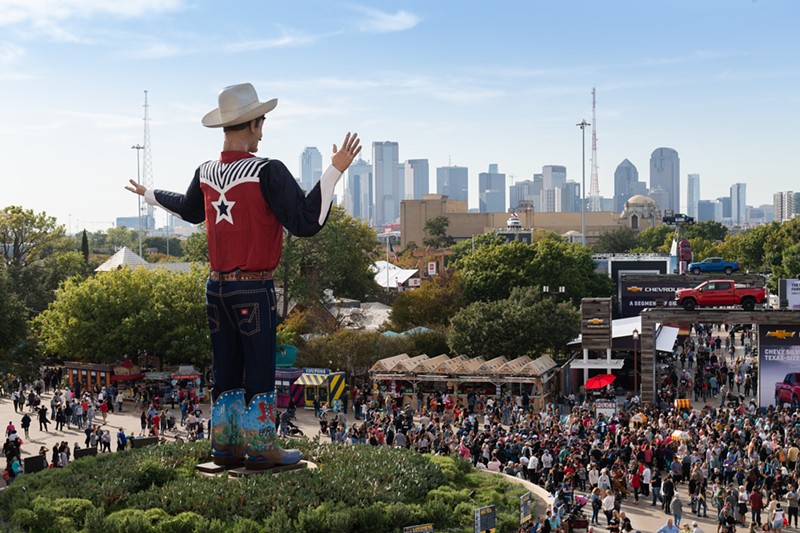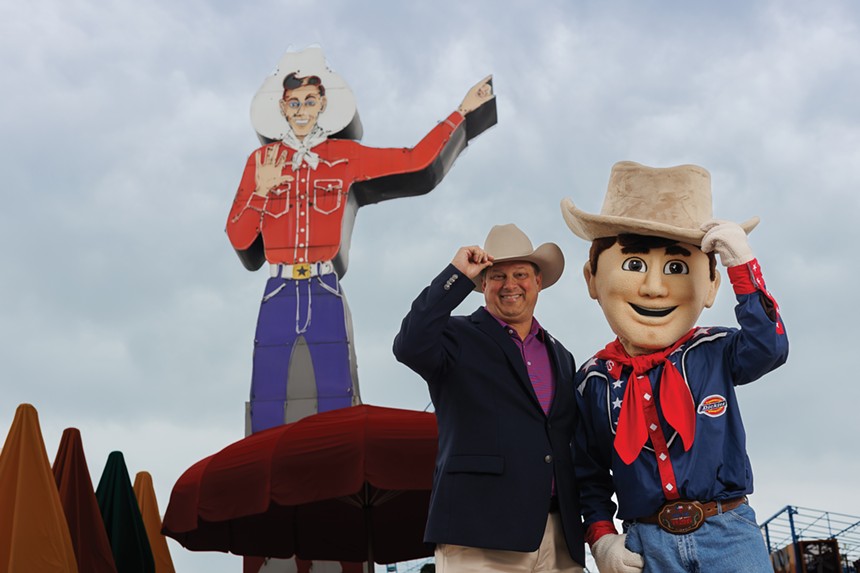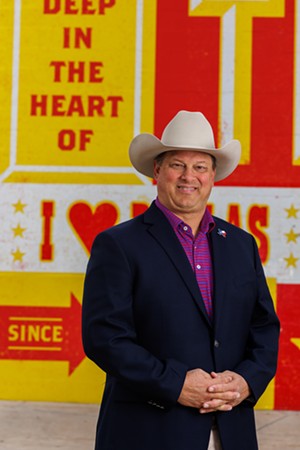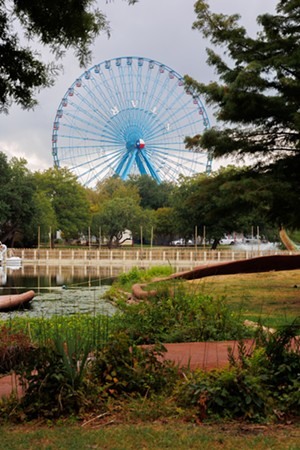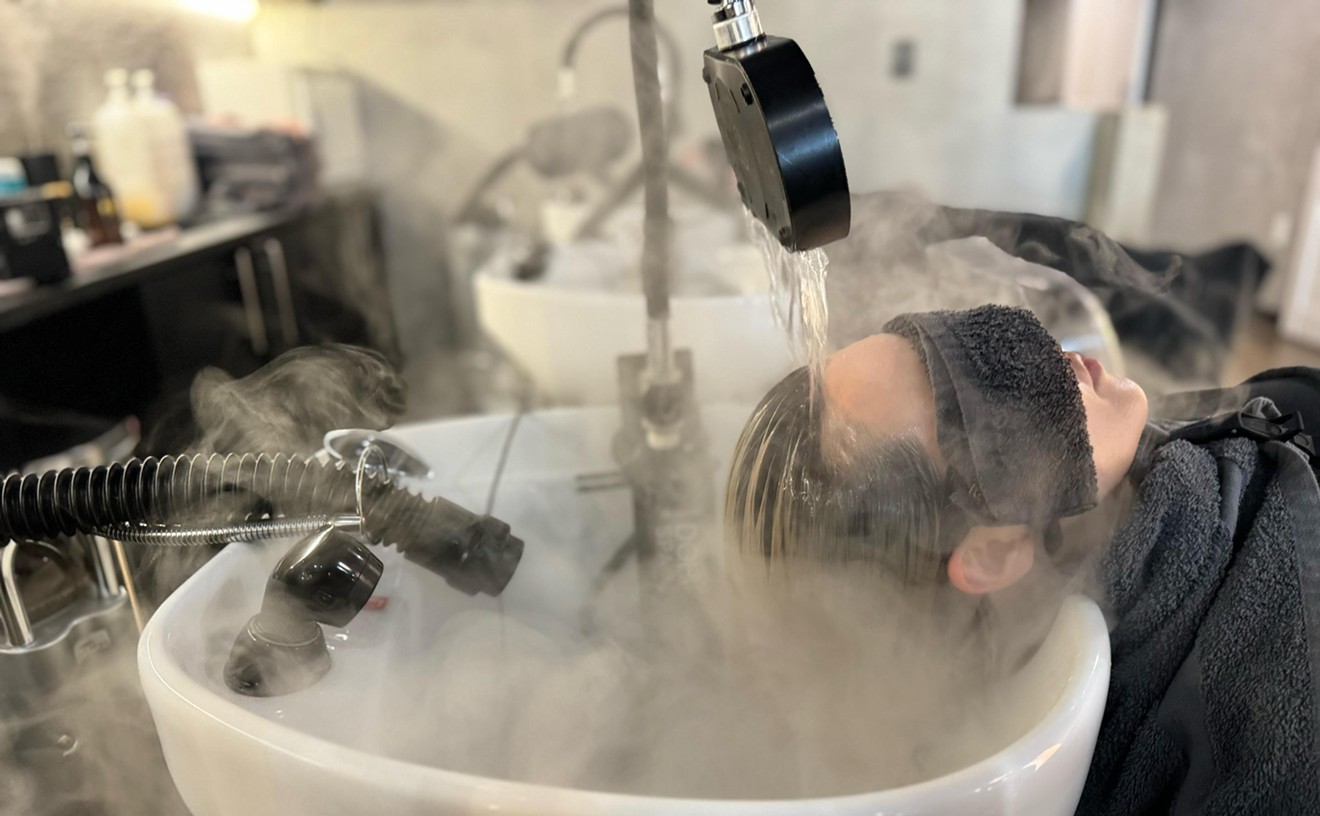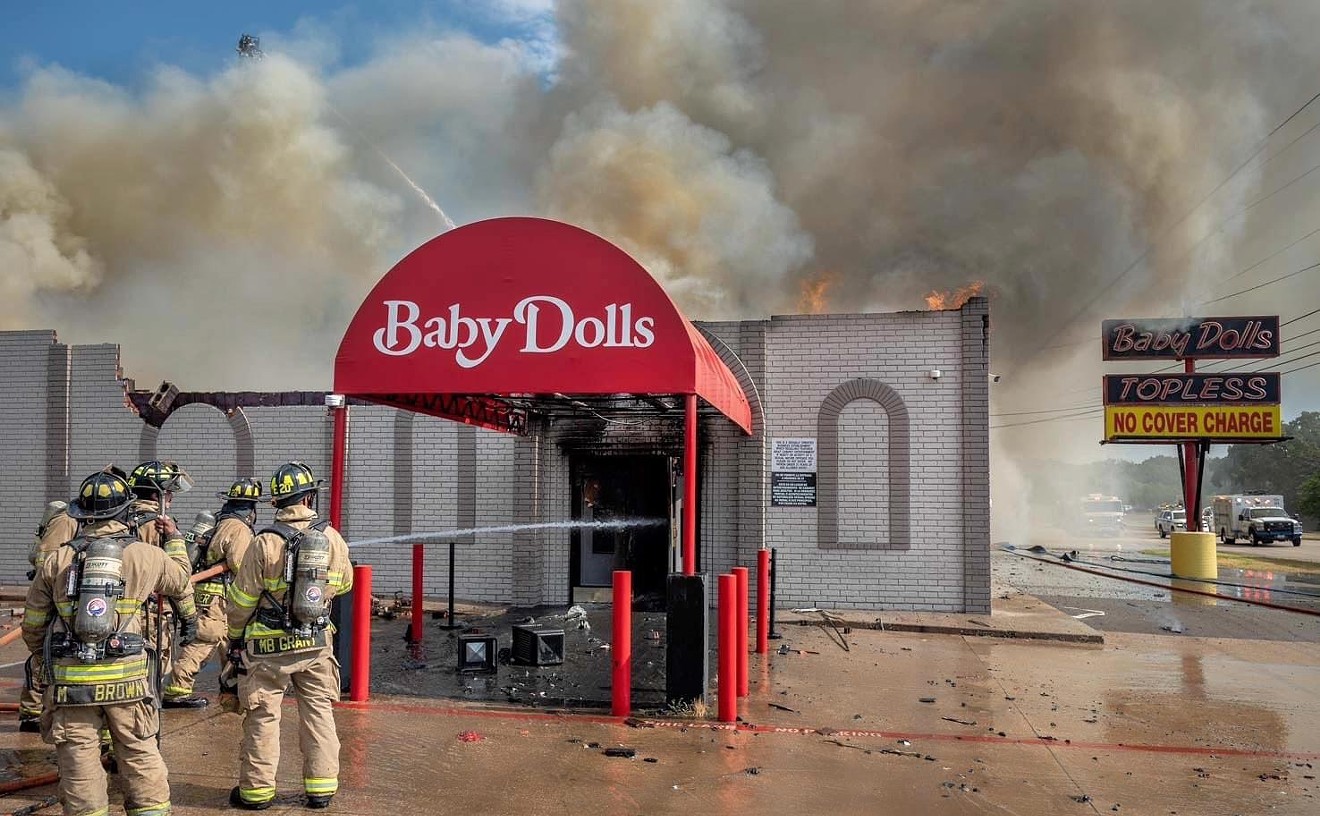All those trials, tribulations and triumphs have brought him to the pinnacle of his life: Having the biggest butt in Texas named after him.
“We’re in Texas, and you’ve got to have a little caboose in your jeans, right?” says Glieber, president of the State Fair of Texas. “After Big Tex burned we rebuilt him, but his behind just didn’t look proportionate. He was flat. All I did was suggest we put some junk in his trunk.”
And that’s how, among the fair's inner circle, 55-foot Big Tex’s voluptuous ass became known simply as “Mitch.”
“I still think it was a good idea,” Glieber says. “Not that I want that to be my legacy … ”
When Glieber was in the first grade, his mother went on vacation alone to Jamaica but never came home. She died under mysterious circumstances amid rumors of chronic back pain and potential addiction to pain medication.
“It’s something,” Glieber says, his voice trailing off during a late-August interview in the fair's administration offices, “that I try not to think about.”
His father, Frank, was famous, but his fame was fleeting.
He was the original radio voice of the Dallas Cowboys in 1960 and a seven-time Texas Sportscaster of the Year honoree for his work announcing everything from Highland Park High School sports to the Texas Rangers to marquee national events such as The Masters. At CBS, he trained a newbie analyst named John Madden. With the Cowboys in 1978 he was part of one of the strongest radio booths in the history of professional sports, alongside National Sportscaster Hall of Fame member Verne Lundquist and Brad Sham, a member of the Texas Radio Hall of Fame now in his 41st season as the voice of the Cowboys.
There were perks to being Frank’s boy, such as having free rein at Cowboys’ summer training camps in Thousand Oaks, California, where Mitchell buzzed around the likes of heroes Roger Staubach, Drew Pearson and coach Tom Landry.
“We rented a house, and for two weeks it was heaven,” Glieber says. “I got to eat with the players and run around the locker room. It was a kid's wonderland.”
Dad’s job, however, required lots of work and even more travel.
“Frank was a sweet, funny and wonderful man,” says ex-wife Kathy White, who was married to him for more than 6 years. “But the truth is, he was gone all the time working.”
As Mitchell was preparing for his graduation from Richardson High School just before noon on May 1, 1985, a counselor approached his classroom and summoned him. Frank had collapsed while jogging on an outdoor track at the Cooper Aerobics Center.
The local members of Frank’s family — he had four marriages and five children — rushed to Medical City Dallas Hospital. Mitchell was the first to arrive, but it was too late. Frank had died of a massive heart attack at the age of 51.
“He literally just dropped dead,” Glieber says. “It forced me to grow up quickly, starting that day.”
Says White: “It was awful, and probably a lot harder for Mitchell than he let me know. He was just a teenager. That was a lot to deal with.”
For reasons equal parts athletic and therapeutic, Glieber dove into playing football at SMU.
He was a walk-on and immediately earned a scholarship as a skinny, crafty receiver. In 1986 he caught only two passes, and then the program was infamously shut down because of a previous recruiting scandal. Ordered dormant for two seasons, the Mustangs were revived in 1989. All the star players had long left for other schools, but Glieber stayed.
“I knew I wasn’t good enough to play in the NFL, and Dallas was my home,” he says. “SMU was good to me, and I felt a sense of loyalty to start things back up.”
The Mustangs lured alum and Pro Football Hall of Fame member Forrest Gregg back to coach and persuaded Glieber — the team’s only scholarship player — to be a senior co-captain of a ship destined to sink.
The Ponies lost their first game by 29 points to lowly Rice, which snapped an 18-game losing streak. Later in the season SMU was mercilessly clobbered by Texas (32 points), Baylor (46 points) and Texas A&M (49 points). The night before their game against No. 1-ranked Notre Dame, Greg attempted to motivate his outmanned team by promising that an upset victory would make them eternal legends, complete with appearances on Good Morning America and The Tonight Show Starring Johnny Carson.
SMU lost, 59-6.
Rock bottom came at the University of Houston when they allowed an NCAA-record 95 points in a historic 74-point drubbing.
But the comeback season also produced one of the most goose-bumpy moments in the history of DFW sports. In their second game, the underdog Mustangs scored 17 points in the final five minutes to rally for a 31-30 victory over Connecticut. After the winning touchdown pass on the game’s dramatic final play, the smattering of fans that had stuck around rickety old Ownby Stadium stormed the field to celebrate the team of gutsy misfits.
It will be forever known as “The Miracle on Mockingbird.”
SMU won only one other game — against lower-division North Texas — all season.
“One of the coolest things I’ve ever been involved in,” says Glieber, who caught 49 passes that season while maintaining a 3.6 GPA in his double major of finance/TV-radio and being named one of the country’s 11 National Football Foundation Scholar Athletes. “We were horrible and we got blown out almost every week. But that game made it all worthwhile.”
“I’m more of an introvert,” he says. “I didn’t have the gift of gab like he did.”
Says White: “Mitchell measures his words. He isn’t one just to get up and feel the need to say something stupid.”
Glieber’s first job was with the Mavericks, where he spent 10 years in the 1990s attempting to sell season tickets for a team so bad they were harpooned as the “Mav-wrecks.”
Through networking contacts made while with the Mavs, Glieber joined the fair’s marketing team in 1999. He rose to president of one of the most successful and popular organizations in the state in 2014. Of his time with the Mavericks, Glieber says, "It was challenging. We never got close to making the playoffs. At the fair, every day feels like a win.
“I’ve had two jobs in my life, both in the events business and both great at bringing people together for a common cause,” says the 56-year-old Glieber, who has three children with wife Lisa. “The thing I love about the fair is that it is uniquely Texan. You can see all walks of life — all ages and ethnicities — comfortably getting along, probably standing in the same line for a corny dog or to ride the Ferris wheel.”
Under Glieber’s decade of leadership, the fair has awarded more than $10 million in local student scholarships, launched a master class for potential small business owners, built a sustainable greenhouse that grows vegetables such as mushrooms and kale, and in 2022 alone paid $1.75 million in rent to the city of Dallas and provided another $9 million for upkeep and renovations to historic Fair Park.
“It’s not like we just set up shop for a couple weeks and then leave,” he said. “We’re here 365 days a year.”
While Mitchell runs the fair, his older brother Craig — in a way — runs the Cowboys.
Craig Glieber also attended SMU in the 1980s and worked alongside Frank and later with the Mavs as a statistician. One of the few remaining holdovers from the Landry era, he then began a 1988 internship with the Cowboys one year before Jerry Jones bought the team.
Craig Glieber was elevated to assistant director of football operations in 1993, and since 2012 has been the team's travel czar. He’s in charge of all the Cowboys’ travel and logistics, from flights, hotels and police escorts on road games to lodging and transportation for visiting free agents and newly signed players.
“I have nightmares that we land and get off the plane and there are no buses waiting for us,” Craig Glieber, says jokingly. “Thankfully, that’s never actually happened.”
He says it’s not a stretch that his brother wound up detouring from the Mavs to the fair.
“They’re both in the entertainment business,” he says. “So it doesn’t surprise me at all. I always knew Mitchell wouldn’t have some boring 9-to-5 job. Neither of us wanted that after seeing what Dad did.”
Despite their access to high-profile events, Craig Glieber says neither brother routinely asks the other for tickets to Cowboys games or the fair.
“The funny thing, it hardly ever happens,” he says with a chuckle. “If I got him tickets to a game he’d probably give them to a VIP client. October is a busy time for me, anyway. Plus, he’s done a great job with the fair, and it’s always crowded. I tend to get lost out there.”
The brothers and White were together most recently in 2022 when Frank was enshrined posthumously into the Texas Sports Hall of Fame in Waco. Sham delivered the induction speech. Mitchell got dad’s ceremonial ring, a sort of gift for his and Lisa’s 30th wedding anniversary.
“They are such amazing human beings,” White says of Frank’s sons. “Those good genes run deep.”
Both men credit Frank with opening industry doors and instilling in them a tireless work ethic.
“I hope he’s proud of us,” Craig Glieber says. “He raised us to stay out of trouble and focus on our careers. I think we’re somewhat successful in the paths we’ve chosen.”
Adds Mitchell: “He’s been gone 38 years, and to this day when I introduce myself the response is ‘Are you related to the great Frank Glieber?’ Dad was a good man and a great role model. It’s important for us to carry on his name in the right way.”
***
In its 137th year, this year’s State Fair of Texas runs Sept. 29 – Oct. 22 and, if history is any indication, it will continue to be immune to life’s little nuisances that paralyze other events — like excessive heat, COVID fears, high gas prices and general woe-is-me concerns about inflation.
Last year the fair set a record for attendance at 2.5 million, including a new single-day mark of 207,000 for Texas-OU Saturday.
“Ticket presales are higher than ever before,” says Glieber, on the cusp of his 10th fair as president. “It looks like we’re going to be in a good place.”
If this year’s theme, “Explore the Midway,” sounds redundant, that’s because it is. Every year the fair attracts millions because of its time-tested tenets: Midway rides, Fletcher’s corny dogs, auto shows, livestock exhibits, concerts, Texas-OU and, of course, 71-year-old Big Tex himself.
Fried food. Football. Fun. What’s not to like?
Some numbers from last year’s fair: 280,000 pounds of donated canned goods, 583,000 scarfed corny dogs, seven million popped kernels of popcorn, 40 dogs rescued to forever homes, 166,000 Ferris wheel rides and one Guinness world record, set when resident strongman Mighty Mike juggled three 10-pound bowling balls for 20 seconds.
The innovative food will be back, led by this year’s award winners: deep-fried pho and bourbon banana carmel sopapillas.
Ditto for football. Texas and OU will play Oct. 7 and, according to Glieber, the two schools will keep their Red River Rivalry at the Cotton Bowl for the foreseeable future. The contract to play at the State Fair of Texas runs out after the 2025 game. But …
“The schools and their alumni have made it very clear they want to keep the game here in Dallas,” Glieber says. “I don’t think Texas–OU leaving will ever happen.”
Before the next deal is agreed upon, however, both schools are requesting significant upgrades to the 93-year-old stadium, which was not built to accommodate almost 100,000 fans. Think wider concourses, more restrooms and reliable Wi-Fi, for starters. To that end, Dallas officials have hired Bryan Trubey, the architect who helped design the Cowboys’ AT&T Stadium, the Minnesota Vikings’ U.S. Bank Stadium and Los Angeles’ SoFi Stadium, to provide recommendations on how to spruce up the joint.
What’s new to this year’s fair? Mainly, a curfew.
Last year a group of troublemaking teens caused a stir, and almost a panicked stampede, when they began running through the Midway yelling “shots fired!” As a result, those under age 18 must be accompanied by a parent or an adult chaperone when entering the gates after 5 p.m.
“It’s the responsible thing for us to do, because we’ve got to be about safety first and foremost,” Glieber says. “We can’t have chaos erupting or people potentially getting injured in our family-friendly environment just because a couple of bad apples were trying to cause trouble.”
Regardless of the old reliable favorites or the new rules, the centerpiece of the fair will remain — this year and forever — Big Tex.
When he went up in flames on Oct. 19, 2012, fans mourned as if for the death of a loved one. As his charred “body” was carried away on a flat-bed truck, tearful fans turned Lone Star Boulevard into a makeshift funeral procession. Over the next week, his sacred post on the fair’s grounds became a memorial adorned by flower bouquets and, yes, corny dogs.
“People were coming up to me and saying ‘Sorry for your loss,’" Glieber says. "We realized more than ever what a powerful icon Big Tex is. Maybe before that we didn’t appreciate him as much as we should have.”
As part of his $500,000 reincarnation, the fair plastered “Big Tex” on everything under its marketing umbrella, to restore and even enhance his larger-than-life persona. Today he remains unofficially the state’s No. 1 hookup destination.
In DFW vernacular there is “Howdy, y’all!”, “How ’bout them Cowboys?!”, “Who shot J.R.?” and “Meet at Big Tex.”
Says fair public relations vice president Karissa Condoianis, “He’s our Mickey Mouse.”
And to those who know him best, his fabled fanny is simply “Mitch.”

